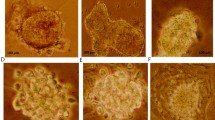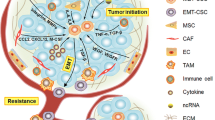Abstract
In view of popularity of cancer stem cell (CSC) model all events in evolution of cancer are being explained in that context. Breast cancer is first solid tumor in which CSCs were identified. We aimed to compare stemness profile of two major subtypes [Estrogen receptor positive (ER+) and negative (ER−)] breast cancer using different sets of markers. Expression of CD44/CD24, CK/Vimentin, E-Cadherin/Fibronectin and percentage of side population (SP) was studied in ER+ (T47D) and ER− (MDA-MB-231) cell lines by flow cytometry. Breast CSCs (BCSCs) were sorted using CD44+/CD24−/low expression and SP analysis and cultured. BCSCs were then compared with Non-CSCs (NCSCs) for response to drugs (Paclitaxel and Cisplatin), Ki67 and ER expression. Results showed higher expression of stemness markers (CD44+/CD24−/low, CK+/Vimentin+ and E-Cadherin−/FibrinectinF+) in MDA-MB-231 cells. Percentage SP representing BCSCs was found to be significantly more in later (3.20 ± 0.002 cf. T47D 1.25% ± 0.0007). BCSCs were found to be more resistant to drugs as compared to NCSCs in both cell lines. ER expression was weak in BCSCs sorted from T47D as compared to NCSCs. Ki67 was expressed in both BCSCs and NCSCs. Differences in expression of stemness markers help to explain aggressive behavior, higher recurrence rate and metastatic potential of MDA-MB-231 cells. However, no correlation amongst different markers used suggests that they may be identifying varied populations of cells in tumor hierarchy. A weak ER expression in BCSCs may be strategy used by BCSCs to escape effect of hormone therapy in ER+ breast cancers.



Similar content being viewed by others
References
Gay L, Baker AM, Graham TA: Tumour Cell Heterogeneity. F1000Res 5, 2016
Gasch C, Ffrench B, O'Leary JJ et al (2017) Catching moving targets: cancer stem cell hierarchies, therapy-resistance & considerations for clinical intervention. Mol Cancer 16:43
Badve S, Nakshatri H (2012) Breast-cancer stem cells-beyond semantics. Lancet Oncol 13:e43–e48
Bozorgi A, Khazaei M, Khazaei MR (2015) New findings on breast Cancer stem cells: a review. J Breast Cancer 18:303–312
Sledge GW, Mamounas EP, Hortobagyi GN, Burstein HJ, Goodwin PJ, Wolff AC (2014) Past, present, and future challenges in breast cancer treatment. J Clin Oncol 32:1979–1986
Dai M, Zhang C, Ali A, et al: CDK4 regulates cancer stemness and is a novel therapeutic target for triple-negative breast cancer. Scientific Reports 6, Article number: 35383, 2016
Chekhun S, Bezdenezhnykh N, Shvets J, Lukianova N (2013) Expression of biomarkers related to cell adhesion, metastasis and invasion of breast cancer cell lines of different molecular subtype. Exp Oncol 35:174–179
Prasetyanti PR, Medema JP (2017) Intra-tumor heterogeneity from a cancer stem cell perspective. Mol Cancer 16:41
Visvader JE, Lindeman GJ (2008) Cancer stem cells in solid tumours: accumulating evidence and unresolved questions. Nat Rev Cancer 8:755–768
Leung EL, Fiscus RR, Tung JW et al (2010) Non-small cell lung cancer cells expressing CD44 are enriched for stem cell-like properties. PLoS One 5:e14062
Godar S, Ince TA, Bell GW, Feldser D, Donaher JL, Bergh J, Liu A, Miu K, Watnick RS, Reinhardt F, McAllister SS, Jacks T, Weinberg RA (2008) Growth-inhibitory and tumor- suppressive functions of p53 depend on its repression of CD44 expression. Cell 134:62–73
Zheng J, Li Y, Yang J et al (2011) NDRG2 inhibits hepatocellular carcinoma adhesion, migration and invasion by regulating CD24 expression. BMC Cancer 11(251):1–9
Cichy J, Pure E (2003) The liberation of CD44. J Cell Biol 161:839–843
Akrap N, Andersson D, Bom E, Gregersson P, Ståhlberg A, Landberg G (2016) Identification of distinct breast Cancer stem cell populations based on single-cell analyses of functionally enriched stem and progenitor pools. Stem Cell Reports 6:121–136
Horimoto Y, Arakawa A, Sasahara N, Tanabe M, Sai S, Himuro T, Saito M (2016) Combination of Cancer stem cell markers CD44 and CD24 is superior to ALDH1 as a prognostic Indicator in breast Cancer patients with distant metastases. PLoS One 11:e0165253
Mani SA, Guo W, Liao MJ, Eaton EN, Ayyanan A, Zhou AY, Brooks M, Reinhard F, Zhang CC, Shipitsin M, Campbell LL, Polyak K, Brisken C, Yang J, Weinberg RA (2008) The epithelial-mesenchymal transition generates cells with properties of stem cells. Cell 133:704–715
Morel AP, Lievre M, Thomas C et al (2008) Generation of breast cancer stem cells through epithelial-mesenchymal transition. PLoS One 3:e2888
Hwang-Verslues WW, Kuo WH, Chang PH, Pan CC, Wang HH, Tsai ST, Jeng YM, Shew JY, Kung JT, Chen CH, Lee EYHP, Chang KJ, Lee WH (2009) Multiple lineages of human breast cancer stem/progenitor cells identified by profiling with stem cell markers. PLoS One 4:e8377
Oh TG, Wang SC, Acharya BR, Goode JM, Graham JD, Clarke CL, Yap AS, Muscat GEO (2016) The nuclear receptor, RORgamma. Regulates Pathways Necessary for Breast Cancer Metastasis EBioMedicine 6:59–72
Walia V, Yu Y, Cao D, Sun M, McLean JR, Hollier BG, Cheng J, Mani SA, Rao K, Premkumar L, Elble RC (2012) Loss of breast epithelial marker hCLCA2 promotes epithelial-to-mesenchymal transition and indicates higher risk of metastasis. Oncogene 31:2237–2246
Armstrong AJ, Marengo MS, Oltean S, Kemeny G, Bitting RL, Turnbull JD, Herold CI, Marcom PK, George DJ, Garcia-Blanco MA (2011) Circulating tumor cells from patients with advanced prostate and breast cancer display both epithelial and mesenchymal markers. Mol Cancer Res 9:997–1007
Polioudaki H, Agelaki S, Chiotaki R, Politaki E, Mavroudis D, Matikas A, Georgoulias V, Theodoropoulos PA (2015) Variable expression levels of keratin and vimentin reveal differential EMT status of circulating tumor cells and correlation with clinical characteristics and outcome of patients with metastatic breast cancer. BMC Cancer 15:399
Christofori G, Semb H (1999) The role of the cell-adhesion molecule E-cadherin as a tumour-suppressor gene. Trends Biochem Sci 24:73–76
Takeichi M (1993) Cadherins in cancer: implications for invasion and metastasis. Curr Opin Cell Biol 5:806–811
Geiger B, Yamada KM (2011) Molecular architecture and function of matrix adhesions. Cold Spring Harb Perspect Biol 3
Sun X, Fa P, Cui Z, Xia Y, Sun L, Li Z, Tang A, Gui Y, Cai Z (2014) The EDA-containing cellular fibronectin induces epithelial-mesenchymal transition in lung cancer cells through integrin alpha9beta1-mediated activation of PI3-K/AKT and Erk1/2. Carcinogenesis 35:184–191
Goodell MA: Stem cell identification and sorting using the Hoechst 33342 side population (SP). Curr Protoc Cytom Chapter 9:Unit9 18, 2005
Britton KM, Eyre R, Harvey IJ, Stemke-Hale K, Browell D, Lennard TWJ, Meeson AP (2012) Breast cancer, side population cells and ABCG2 expression. Cancer Lett 323:97–105
Nakanishi T, Chumsri S, Khakpour N, Brodie AH, Leyland-Jones B, Hamburger AW, Ross DD, Burger AM (2010) Side-population cells in luminal-type breast cancer have tumour-initiating cell properties, and are regulated by HER2 expression and signalling. Br J Cancer 102:815–826
Jin C, Zou T, Li J et al (2015) Side population cell level in human breast cancer and factors related to disease-free survival. Asian Pac J Cancer Prev 16:991–996
Liu Y, Nenutil R, Appleyard MV, Murray K, Boylan M, Thompson AM, Coates PJ (2014) Lack of correlation of stem cell markers in breast cancer stem cells. Br J Cancer 110(8):2063–2071
Dontu G, Abdallah WM, Foley JM, Jackson KW, Clarke MF, Kawamura MJ, Wicha MS (2003) In vitro propagation and transcriptional profiling of human mammary stem/progenitor cells. Genes Dev 17:1253–1270
Ponti D, Costa A, Zaffaroni N, Pratesi G, Petrangolini G, Coradini D, Pilotti S, Pierotti MA, Daidone MG (2005) Isolation and in vitro propagation of tumorigenic breast cancer cells with stem/progenitor cell properties. Cancer Res 65:5506–5511
Manuel Iglesias J, Beloqui I, Garcia-Garcia F, Leis O, Vazquez-Martin A, Eguiara A, Cufi S, Pavon A, Menendez JA, Dopazo J, Martin AG (2013) Mammosphere formation in breast carcinoma cell lines depends upon expression of E-cadherin. PLoS One 8:e77281
Shafee N, Smith CR, Wei S, Kim Y, Mills GB, Hortobagyi GN, Stanbridge EJ, Lee EYHP (2008) Cancer stem cells contribute to cisplatin resistance in Brca1/p53-mediated mouse mammary tumors. Cancer Res 68:3243–3250
Dean M, Fojo T, Bates S (2005) Tumour stem cells and drug resistance. Nat Rev Cancer 5:275–284
Phillips TM, McBride WH, Pajonk F (2006) The response of CD24(−/low)/CD44+ breast cancer-initiating cells to radiation. J Natl Cancer Inst 98:1777–1785
Cidado J, Wong HY, Rosen DM, Cimino-Mathews A, Garay JP, Fessler AG, Rasheed ZA, Hicks J, Cochran RL, Croessmann S, Zabransky DJ, Mohseni M, Beaver JA, Chu D, Cravero K, Christenson ES, Medford A, Mattox A, de Marzo AM, Argani P, Chawla A, Hurley PJ, Lauring J, Park BH (2016) Ki-67 is required for maintenance of cancer stem cells but not cell proliferation. Oncotarget 7:6281–6293
Guttilla IK, Phoenix KN, Hong X, Tirnauer JS, Claffey KP, White BA (2012) Prolonged mammosphere culture of MCF-7 cells induces an EMT and repression of the estrogen receptor by microRNAs. Breast Cancer Res Treat 132:75–85
Voutsadakis IA (2016) Epithelial-Mesenchymal transition (EMT) and regulation of EMT factors by steroid nuclear receptors in breast Cancer: a review and in Silico investigation. J Clin Med 5
Acknowledgements
We acknowledge the funding support provided by PGIMER for this work.
Author information
Authors and Affiliations
Corresponding author
Rights and permissions
About this article
Cite this article
Chopra, S., Goel, S., Thakur, B. et al. Do Different Stemness Markers Identify Different Pools of Cancer Stem Cells in Malignancies: A Study on ER+ and ER-Breast Cancer Cell Lines. Pathol. Oncol. Res. 26, 371–378 (2020). https://doi.org/10.1007/s12253-018-0503-8
Received:
Accepted:
Published:
Issue Date:
DOI: https://doi.org/10.1007/s12253-018-0503-8




